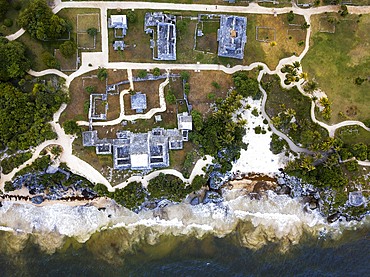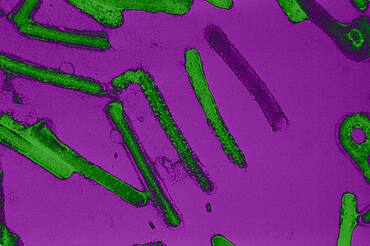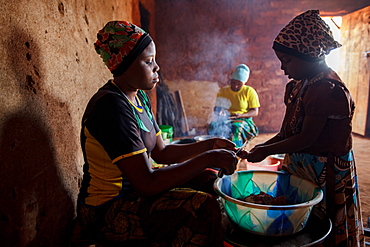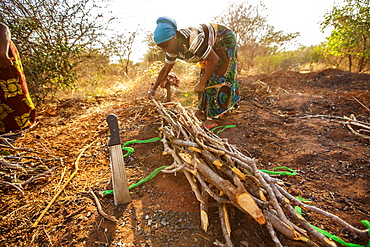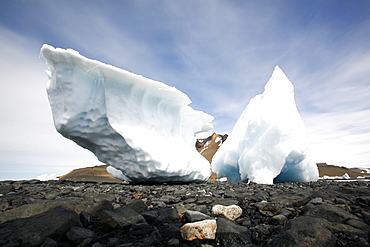Recent searches
Loading...
1350-6597 - Aerial views of El Castillo and the Ruins of the Mayan temple grounds at Tulum, Quintana Roo, Yucatan, Mexico. Tulum is the site of a pre-Columbian Mayan walled city which served as a major port for Coba, in the Mexican state of Quintana Roo. The ruins are situated on 12 meter 39 ft tall cliffs along the east coast of the Yucatán Peninsula on the Caribbean Sea in the state of Quintana Roo, Mexico. Tulum was one of the last cities built and inhabited by the Maya; it was at its height between the 13th and 15th centuries and managed to survive about 70 years after the Spanish began occupying Mexico. Old World diseases brought by the Spanish settlers appear to have resulted in very high fatalities, disrupting the society, and eventually causing the city to be abandoned.
1350-6599 - Aerial views of El Castillo and the Ruins of the Mayan temple grounds at Tulum, Quintana Roo, Yucatan, Mexico. Tulum is the site of a pre-Columbian Mayan walled city which served as a major port for Coba, in the Mexican state of Quintana Roo. The ruins are situated on 12 meter 39 ft tall cliffs along the east coast of the Yucatán Peninsula on the Caribbean Sea in the state of Quintana Roo, Mexico. Tulum was one of the last cities built and inhabited by the Maya; it was at its height between the 13th and 15th centuries and managed to survive about 70 years after the Spanish began occupying Mexico. Old World diseases brought by the Spanish settlers appear to have resulted in very high fatalities, disrupting the society, and eventually causing the city to be abandoned.
860-290377 - France. Hunting. The European commission has adopted in january 2021 a ban on using lead 100m around any wetland in Europe. So far in France, the ban is only 30m. In the future, the lead will be totally banned as 6000 tons of lead is put into nature by hunters every year causing death of thousands of birds (here a mallard) eating lead balls.
860-290376 - France. Hunting. The European commission has adopted in january 2021 a ban on using lead 100m around any wetland in Europe. So far in France, the ban is only 30m. In the future, the lead will be totally banned as 6000 tons of lead is put into nature by hunters every year causing death of thousands of birds (here a mallard) eating lead balls.
1348-1075 - This electron micrograph depicts a number of Marburg virions responsible for causing Marburg Hemorrhagic Fever.
1348-1655 - Gadolinium enhanced MRI-T1. Coronal cut-away. Idiopathic metastases causing generalized epileptic seizures in a 40-year old man.
1116-42819 - Agriculture - Fresh burn scars in wheat stubble. Wheat stubble is burned after harvest to eliminate fungus growth on the stubble which causes damage to the following years crop / near Casselton, North Dakota, USA.
857-94727 - Mforo, Tanzania a village near Moshi, Tanzania. Solar Sister entrepreneur Fatma Mziray and her eldest daughter Zainabu Ramadhani, 19 cook lunch in her kitchen house using both a clean cookstove using wood and one using coal. One of her younger daughters, Nasma Ramadhani, age 5 helps out. Fatma Mziray is a Solar Sister entrepreneur who sells both clean cookstoves and solar lanterns. Fatma heard about the cookstoves from a Solar Sister development associate and decided to try one out. The smoke from cooking on her traditional wood stove using firewood was causing her to have a lot of heath problems, her lungs congested her eyes stinging and her doctor told her that she had to stop cooking that way. Some days she felt so bad she couldn't go in to cook. Fatma said, âCooking for a family, preparing breakfast, lunch and dinner I used to gather a large load of wood every day to use. Now with the new cook stove the same load of wood can last up to three weeks of cooking. âWith the extra time I can develop my business. I also have more time for the family. I can monitor my childrenâs studies. All of this makes for a happier family and a better relationship with my husband. Since using the clean cookstove no one has been sick or gone to the hospital due to flu.â Fatma sees herself helping her community because she no longer sees the people that she has sold cookstoves have red eyes, coughing or sick like they used to be. She has been able to help with the school fees for her children, purchase items for the home and a cow. âWhat makes me wake up early every morning and take my cookstoves and go to my business is to be able to take my family to school as well as to get food and other family needs.â
857-94726 - Zainabu Ramadhani, 19, (yellow and red patterned skirt) her mother Fatma Mziray, age 38, (blue head dress) and Fatmaâs sister-in-law Zaitun Hamad, 18, (orange wrap and white top) walk home after gathering firewood near Fatmaâs home in Mforo. Mforo is near Moshi, Tanzania. Fatma Mziray is a Solar Sister entrepreneur who sells both clean cookstoves and solar lanterns. Fatma heard about the cookstoves from a Solar Sister development associate and decided to try one out. The smoke from cooking on her traditional wood stove using firewood was causing her to have a lot of heath problems, her lungs congested her eyes stinging and her doctor told her that she had to stop cooking that way. Some days she felt so bad she couldn't go in to cook. Fatma said, âCooking for a family, preparing breakfast, lunch and dinner I used to gather a large load of wood every day to use. Now with the new cook stove the same load of wood can last up to three weeks of cooking. âWith the extra time I can develop my business. I also have more time for the family. I can monitor my childrenâs studies. All of this makes for a happier family and a better relationship with my husband. Since using the clean cookstove no one has been sick or gone to the hospital due to flu.â Fatma sees herself helping her community because she no longer sees the people that she has sold cookstoves have red eyes, coughing or sick like they used to be. She has been able to help with the school fees for her children, purchase items for the home and a cow. âWhat makes me wake up early every morning and take my cookstoves and go to my business is to be able to take my family to school as well as to get food and other family needs.â
857-94728 - Zainabu Ramadhani, 19, (yellow and red patterned skirt) her mother Fatma Mziray, age 38, (blue head dress) and Fatmaâs sister-in-law Zaitun Hamad, 18, (orange wrap and white top) walk home after gathering firewood near Fatmaâs home in Mforo. Mforo is near Moshi, Tanzania. Fatma Mziray is a Solar Sister entrepreneur who sells both clean cookstoves and solar lanterns. Fatma heard about the cookstoves from a Solar Sister development associate and decided to try one out. The smoke from cooking on her traditional wood stove using firewood was causing her to have a lot of heath problems, her lungs congested her eyes stinging and her doctor told her that she had to stop cooking that way. Some days she felt so bad she couldn't go in to cook. Fatma said, âCooking for a family, preparing breakfast, lunch and dinner I used to gather a large load of wood every day to use. Now with the new cook stove the same load of wood can last up to three weeks of cooking. âWith the extra time I can develop my business. I also have more time for the family. I can monitor my childrenâs studies. All of this makes for a happier family and a better relationship with my husband. Since using the clean cookstove no one has been sick or gone to the hospital due to flu.â Fatma sees herself helping her community because she no longer sees the people that she has sold cookstoves have red eyes, coughing or sick like they used to be. She has been able to help with the school fees for her children, purchase items for the home and a cow. âWhat makes me wake up early every morning and take my cookstoves and go to my business is to be able to take my family to school as well as to get food and other family needs.â
857-94729 - Zainabu Ramadhani, 19, (yellow and red patterned skirt) her mother Fatma Mziray, age 38, (blue head dress) and Fatmaâs sister-in-law Zaitun Hamad, 18, (orange wrap and white top) walk home after gathering firewood near Fatmaâs home in Mforo. Mforo is near Moshi, Tanzania. Fatma Mziray is a Solar Sister entrepreneur who sells both clean cookstoves and solar lanterns. Fatma heard about the cookstoves from a Solar Sister development associate and decided to try one out. The smoke from cooking on her traditional wood stove using firewood was causing her to have a lot of heath problems, her lungs congested her eyes stinging and her doctor told her that she had to stop cooking that way. Some days she felt so bad she couldn't go in to cook. Fatma said, âCooking for a family, preparing breakfast, lunch and dinner I used to gather a large load of wood every day to use. Now with the new cook stove the same load of wood can last up to three weeks of cooking. âWith the extra time I can develop my business. I also have more time for the family. I can monitor my childrenâs studies. All of this makes for a happier family and a better relationship with my husband. Since using the clean cookstove no one has been sick or gone to the hospital due to flu.â Fatma sees herself helping her community because she no longer sees the people that she has sold cookstoves have red eyes, coughing or sick like they used to be. She has been able to help with the school fees for her children, purchase items for the home and a cow. âWhat makes me wake up early every morning and take my cookstoves and go to my business is to be able to take my family to school as well as to get food and other family needs.â
911-10652 - Rotten sea ice at over 80 degrees North off the north coast of Svalbard. Climate change is causing sea ice to retreat rapidly. The latest science predicts that the Arctic will be completely ice free in the summer around 2054. The sea ice broke up very early around Svalbard in 2013.
911-10653 - Rotten sea ice at over 80 degrees North off the north coast of Svalbard. Climate change is causing sea ice to retreat rapidly. The latest science predicts that the Arctic will be completely ice free in the summer around 2054. The sea ice broke up very early around Svalbard in 2013.
911-10237 - A Kittiwake, Rissa tridactyla, on the Farne Islands, Northumberland, UK, next to a pool with red algae. Kittiwakes have declined drastically due to climate change causing their main fish prey species to migrate further north to find cooler sea temperatures.
911-9947 - Guano in an Adelie Penguin, Pygoscelis adeliae, colony at Madder Cliffs, Suspiros Bay, at the west end of Joinville Island, Antarctica. Adelie's are a true Antarctic species which are suffering as a result of climate change, The Antarctic Peninsular, their only breeding grounds, is one of the fastest warming areas on the planet. This is causing Adelies to migrate south. They are reducing in numbers, they feed almost exclusively on Krill, which is also declining as a result of climate change.
832-155570 - Storm Xynthia causing high waves on the shore of Reichenau island and rain, looking towards Radolfzell, Lake Constance, Untersee lake, Landkreis Konstanz county, Baden-Wuerttemberg, Germany, Europe
832-145703 - Young people pushing towards the exit causing a jam, mass panic leaving 21 dead, Loveparade 2010, Duisburg, North Rhine-Westfalia, Germany, Europe
832-145704 - Young people pushing towards the exit causing a jam, mass panic leaving 21 dead, Loveparade 2010, Duisburg, North Rhine-Westfalia, Germany, Europe
911-9333 - A gaping hole left where a massive block of ice detached causing an avalanche on Machapuchare (Fishtail Peak) in the Annapurna Himalaya, Nepal, Asia
857-79655 - A female water skier rips a turn causing a huge water spray while skiing on Cobbosseecontee Lake near Monmouth, Maine.
857-79657 - A female water skier rips a turn causing a huge water spray while skiing on Cobbosseecontee Lake near Monmouth, Maine.
857-79658 - A female water skier rips a turn causing a huge water spray while skiing on Cobbosseecontee Lake near Monmouth, Maine.
979-2239 - Iceberg detail in and around the Antarctic Peninsula during the summer months. More icebergs are being created as global warming is causing the breakup of major ice shelves and glaciers.
979-2263 - Iceberg detail in and around the Antarctic Peninsula during the summer months. More icebergs are being created as global warming is causing the breakup of major ice shelves and glaciers.
979-2254 - Iceberg detail in and around the Antarctic Peninsula during the summer months. More icebergs are being created as global warming is causing the breakup of major ice shelves and glaciers.
979-2255 - Iceberg detail in and around the Antarctic Peninsula during the summer months. More icebergs are being created as global warming is causing the breakup of major ice shelves and glaciers.
979-2181 - Iceberg detail in and around the Antarctic Peninsula during the summer months. More icebergs are being created as global warming is causing the breakup of major ice sheets.
979-2265 - Iceberg detail in and around the Antarctic Peninsula during the summer months. More icebergs are being created as global warming is causing the breakup of major ice shelves and glaciers.
979-2180 - Iceberg detail in and around the Antarctic Peninsula during the summer months. More icebergs are being created as global warming is causing the breakup of major ice sheets.
979-2233 - Iceberg detail in and around the Antarctic Peninsula during the summer months. More icebergs are being created as global warming is causing the breakup of major ice shelves and glaciers.
979-2241 - Iceberg detail in and around the Antarctic Peninsula during the summer months. More icebergs are being created as global warming is causing the breakup of major ice shelves and glaciers.
979-2261 - Iceberg detail in and around the Antarctic Peninsula during the summer months. More icebergs are being created as global warming is causing the breakup of major ice shelves and glaciers.
979-2260 - Iceberg detail in and around the Antarctic Peninsula during the summer months. More icebergs are being created as global warming is causing the breakup of major ice shelves and glaciers.
979-4478 - Iceberg detail in and around the Antarctic Peninsula during the summer months. More icebergs are being created as global warming is causing the breakup of major ice shelves and glaciers.
979-2251 - Iceberg detail in and around the Antarctic Peninsula during the summer months. More icebergs are being created as global warming is causing the breakup of major ice shelves and glaciers.
979-2232 - Iceberg detail in and around the Antarctic Peninsula during the summer months. More icebergs are being created as global warming is causing the breakup of major ice shelves and glaciers.
979-2177 - Grounded iceberg detail in and around the Antarctic Peninsula during the summer months. More icebergs are being created as global warming is causing the breakup of major ice sheets.
979-4479 - Iceberg detail in and around the Antarctic Peninsula during the summer months. More icebergs are being created as global warming is causing the breakup of major ice shelves and glaciers.
979-2259 - Iceberg detail in and around the Antarctic Peninsula during the summer months. More icebergs are being created as global warming is causing the breakup of major ice shelves and glaciers.
979-2264 - Iceberg detail in and around the Antarctic Peninsula during the summer months. More icebergs are being created as global warming is causing the breakup of major ice shelves and glaciers.
979-2257 - Iceberg detail in and around the Antarctic Peninsula during the summer months. More icebergs are being created as global warming is causing the breakup of major ice shelves and glaciers.
979-2183 - Iceberg detail in and around the Antarctic Peninsula during the summer months. More icebergs are being created as global warming is causing the breakup of major ice sheets.
979-2238 - Iceberg detail in and around the Antarctic Peninsula during the summer months. More icebergs are being created as global warming is causing the breakup of major ice shelves and glaciers.
979-2243 - Iceberg detail in and around the Antarctic Peninsula during the summer months. More icebergs are being created as global warming is causing the breakup of major ice shelves and glaciers.
979-2247 - Brash ice detail in and around the Antarctic Peninsula during the summer months. More icebergs are being created as global warming is causing the breakup of major ice shelves and glaciers.
979-2179 - Iceberg detail in and around the Antarctic Peninsula during the summer months. More icebergs are being created as global warming is causing the breakup of major ice sheets.
979-2237 - Iceberg detail in and around the Antarctic Peninsula during the summer months. More icebergs are being created as global warming is causing the breakup of major ice shelves and glaciers.
979-2256 - Iceberg detail in and around the Antarctic Peninsula during the summer months. More icebergs are being created as global warming is causing the breakup of major ice shelves and glaciers.
979-2253 - Iceberg detail in and around the Antarctic Peninsula during the summer months. More icebergs are being created as global warming is causing the breakup of major ice shelves and glaciers.
979-2234 - Iceberg detail in and around the Antarctic Peninsula during the summer months. More icebergs are being created as global warming is causing the breakup of major ice shelves and glaciers.
979-2176 - Edge of an iceberg in and around the Antarctic Peninsula during the summer months. More icebergs are being created as global warming is causing the breakup of major ice sheets.
979-7094 - Iceberg detail in and around the Antarctic Peninsula during the summer months. More icebergs are being created as global warming is causing the breakup of major ice shelves and glaciers.
979-7095 - Iceberg detail in and around the Antarctic Peninsula during the summer months. More icebergs are being created as global warming is causing the breakup of major ice shelves and glaciers.
979-2178 - Iceberg detail in and around the Antarctic Peninsula during the summer months. More icebergs are being created as global warming is causing the breakup of major ice sheets.
979-2240 - Iceberg detail in and around the Antarctic Peninsula during the summer months. More icebergs are being created as global warming is causing the breakup of major ice shelves and glaciers.
979-2245 - Iceberg detail in and around the Antarctic Peninsula during the summer months. More icebergs are being created as global warming is causing the breakup of major ice shelves and glaciers.
979-2258 - Iceberg detail in and around the Antarctic Peninsula during the summer months. More icebergs are being created as global warming is causing the breakup of major ice shelves and glaciers.
979-4480 - Iceberg detail in and around the Antarctic Peninsula during the summer months. More icebergs are being created as global warming is causing the breakup of major ice shelves and glaciers.
979-2262 - Iceberg detail in and around the Antarctic Peninsula during the summer months. More icebergs are being created as global warming is causing the breakup of major ice shelves and glaciers.
979-2182 - Iceberg detail in and around the Antarctic Peninsula during the summer months. More icebergs are being created as global warming is causing the breakup of major ice sheets.
979-2235 - Iceberg detail in and around the Antarctic Peninsula during the summer months. More icebergs are being created as global warming is causing the breakup of major ice shelves and glaciers.
979-4481 - Iceberg detail in and around the Antarctic Peninsula during the summer months. More icebergs are being created as global warming is causing the breakup of major ice shelves and glaciers.
979-2236 - Iceberg detail in and around the Antarctic Peninsula during the summer months. More icebergs are being created as global warming is causing the breakup of major ice shelves and glaciers.
979-2266 - Iceberg detail in and around the Antarctic Peninsula during the summer months. More icebergs are being created as global warming is causing the breakup of major ice shelves and glaciers.
911-7731 - A new build housing development that was abandoned when the Spanish economy collapsed during the recession, causing the developer to become bankrupt, near Sanlucar La Mayor, Spain.
911-7730 - A new build housing development that was abandoned when the Spanish economy collapsed during the recession, causing the developer to become bankrupt, near Sanlucar La Mayor, Spain.
911-7720 - Fire restrictions sign on Ogden Moor near Wainstalls above Halifax where after the driest April on record moorland fires broke out, causing the windfarm to close, Yorkshire, England, United Kingdom, Europe
911-6964 - Pseudocraters at Kirkjubaejarklauster, formed by lava erupting onto a wet surface causing explosions of steam, Iceland, Polar Regions
831-362 - Mongolian goats travelling overland causing traffic jam on Himalayan road between Pokhara and Nayapul, Nepal, Asia
797-1839 - BRAZIL Serra Pelada Illegal use of mercury in gold mine causing pollution. Brasil Brazil
390-763 - Roadworks causing traffic jam on the M25, England, United Kingdom, Europe
312-1812 - Between the villages of Nyaung U and Wetkyi-in, 10cm. pool of water in stone slab (made to allow former Burmese monarchs to view hti in reflection without tipping their heads back - causing them to lose their crowns), Shwezigon Paya, Bagan (Pagan), Myanmar (Burma), Asia Shwezigon Paya first built by King Anawrahta and completed by King Kyansittha in 1087 Shwezigon Paya first built by King Anawrahta and completed by King Kyansittha in 1087
You reached the end of search results

